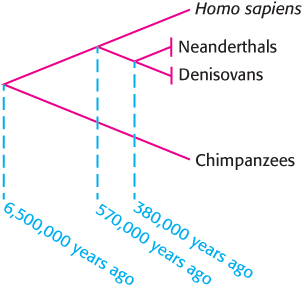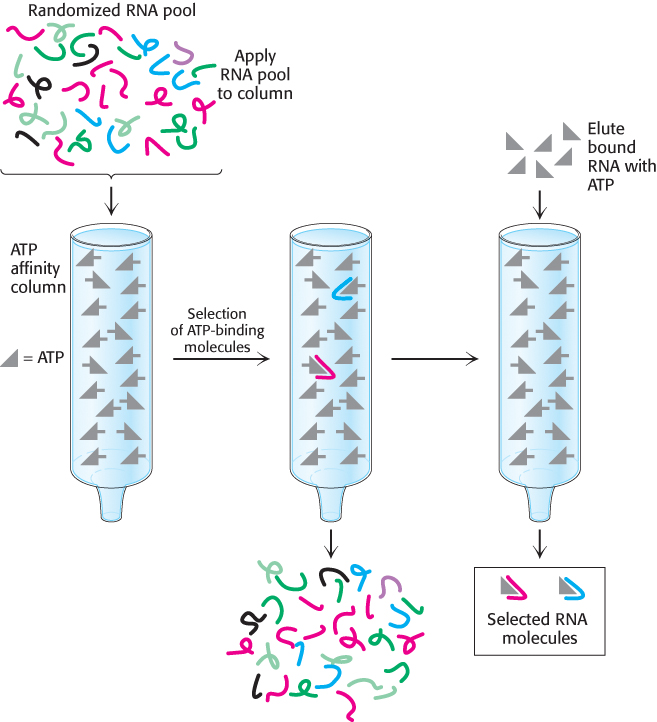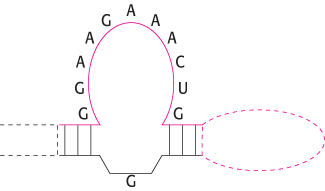Ancient DNA can sometimes be amplified and sequenced

Figure 6.24: Placing Neanderthals and Denisovans on an evolutionary tree. Comparison of DNA sequences revealed that neither Neanderthals nor the Denisovans are on the line of direct descent leading to Homo sapiens but, instead, branched off earlier and then became extinct.
The tremendous chemical stability of DNA makes the molecule well suited to its role as the storage site of genetic information. So stable is the molecule that samples of DNA have survived for many thousands of years under appropriate conditions. With the development of PCR and advanced DNA-sequencing methods, such ancient DNA can be amplified and sequenced. This approach was first applied to mitochondrial DNA isolated from a Neanderthal fossil estimated at 38,000 years of age. Comparison of the complete Neanderthal mitochondrial sequence with those from Homo sapiens individuals revealed between 201 and 234 substitutions, considerably fewer than the approximately 1500 differences between human beings and chimpanzees over the same region.
Remarkably, the complete genome sequences of a Neanderthal and a closely related hominin known as a Denisovan have been obtained using DNA isolated from nearly 50,000-year-old fossils. Comparison of these sequences suggests that the common ancestor of modern human beings and Neanderthals lived approximately 570,000 years ago, while the common ancestor between Neanderthals and Denisovans lived nearly 380,000 years ago. An evolutionary tree constructed from these data revealed that the Neanderthal was not an intermediate between chimpanzees and human beings but, instead, was an evolutionary “dead end” that became extinct (Figure 6.24). Further analysis of these sequences has enabled researchers to determine the extent of interbreeding between these groups, elucidate the geographic history of these populations, and make assertions about additional ancestors whose DNA has not yet been sequenced.
A few earlier studies claimed to determine the sequences of far more ancient DNA such as that found in insects trapped in amber, but these studies appear to have been flawed. The source of these sequences turned out to be contaminating modern DNA. Successful sequencing of ancient DNA requires sufficient DNA for reliable amplification and the rigorous exclusion of all sources of contamination.
Molecular evolution can be examined experimentally
Evolution requires three processes: (1) the generation of a diverse population, (2) the selection of members based on some criterion of fitness, and (3) reproduction to enrich the population in these more-fit members. Nucleic acid molecules are capable of undergoing all three processes in vitro under appropriate conditions. The results of such studies enable us to glimpse how evolutionary processes might have generated catalytic activities and specific binding abilities—important biochemical functions in all living systems.
A diverse population of nucleic acid molecules can be synthesized in the laboratory by the process of combinatorial chemistry, which rapidly produces large populations of a particular type of molecule such as a nucleic acid. A population of molecules of a given size can be generated randomly so that many or all possible sequences are present in the mixture. When an initial population has been generated, it is subjected to a selection process that isolates specific molecules with desired binding or reactivity properties. Finally, molecules that have survived the selection process are replicated through the use of PCR; primers are directed toward specific sequences included at the ends of each member of the population. Errors that occur naturally in the course of the replication process introduce additional variation into the population in each “generation.” Let us consider an application of this approach. Early in evolution, before the emergence of proteins, RNA molecules may have played all major roles in biological catalysis. To understand the properties of potential RNA catalysts, researchers have used the methods heretofore described to create an RNA molecule capable of binding adenosine triphosphate and related nucleotides. An initial population of RNA molecules 169 nucleotides long was created; 120 of the positions differed randomly, with equimolar mixtures of adenine, cytosine, guanine, and uracil. The initial synthetic pool that was used contained approximately 1014 RNA molecules. Note that this number is a very small fraction of the total possible pool of random 120-base sequences. From this pool, those molecules that bound to ATP, which had been immobilized on a column, were selected (Figure 6.25).

Figure 6.25: Evolution in the laboratory. A collection of RNA molecules of random sequences is synthesized by combinatorial chemistry. This collection is selected for the ability to bind ATP by passing the RNA through an ATP affinity column (Section 3.1). The ATP-binding RNA molecules are released from the column by washing with excess ATP and then replicated. The process of selection and replication is then repeated several times. The final RNA products with significant ATP-binding ability are isolated and characterized.

Figure 6.26: A conserved secondary structure. The secondary structure shown is common to RNA molecules selected for ATP binding.
The collection of molecules that were bound well by the ATP affinity column was replicated by reverse transcription into DNA, amplification by PCR, and transcription back into RNA. The somewhat error-prone reverse transcriptase may have introduced additional mutations into the population in each cycle. The new population was subjected to additional rounds of selection for ATP-binding activity. After eight generations, members of the selected population were characterized by sequencing. Seventeen different sequences were obtained, 16 of which could form the structure shown in Figure 6.26. Each of these molecules bound ATP with dissociation constants less than 50 μM.
The folded structure of the ATP-binding region from one of these RNAs was determined by nuclear magnetic resonance (NMR) methods (Section 3.5). As expected, this 40-nucleotide molecule is composed of two Watson–Crick base-paired helical regions separated by an 11-nucleotide loop (Figure 6.27A). This loop folds back on itself in an intricate way (Figure 6.27B) to form a deep pocket into which the adenine ring can fit (Figure 6.27C). Thus, a structure had evolved in vitro that was capable of a specific interaction.

Figure 6.27: An evolved ATP-binding RNA molecule. (A) The Watson–Crick base-pairing pattern of an RNA molecule selected to bind adenosine nucleotides. (B) The NMR structure of this RNA molecule reveals the deep pocket into which the ATP molecule is bound. (C) In this surface representation, the ATP molecule has been removed to enable visualization of the pocket.
[Drawn from 1RAW.pdb.]
 Synthetic oligonucleotides that can specifically bind ligands, such as the ATP-binding RNA molecules described above, are referred to as aptamers. In addition to their role in understanding molecular evolution, aptamers have shown promise as versatile tools for biotechnology and medicine. They have been developed for diagnostic applications, serving as sensors for ligands ranging from small organic molecules, such as cocaine, to larger proteins, such as thrombin. Several aptamers are also in clinical trials as therapies for diseases ranging from leukemia to diabetes. Macugen (pegaptanib sodium), an aptamer which binds to and inhibits the protein vascular endothelial growth factor (VEGF), has been approved for the treatment of age-related macular degeneration.
Synthetic oligonucleotides that can specifically bind ligands, such as the ATP-binding RNA molecules described above, are referred to as aptamers. In addition to their role in understanding molecular evolution, aptamers have shown promise as versatile tools for biotechnology and medicine. They have been developed for diagnostic applications, serving as sensors for ligands ranging from small organic molecules, such as cocaine, to larger proteins, such as thrombin. Several aptamers are also in clinical trials as therapies for diseases ranging from leukemia to diabetes. Macugen (pegaptanib sodium), an aptamer which binds to and inhibits the protein vascular endothelial growth factor (VEGF), has been approved for the treatment of age-related macular degeneration.




 Synthetic oligonucleotides that can specifically bind ligands, such as the ATP-
Synthetic oligonucleotides that can specifically bind ligands, such as the ATP-